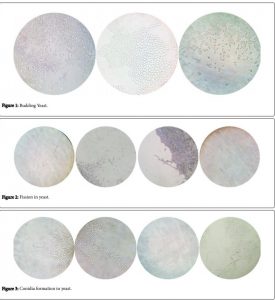General characteristics of Yeast
- Yeast is basically chemorganotrophs as they can use the inorganic chemical as a source of energy.
- Mostly yeast isolated from the surfaces of fruit and berries like apple, peaches and exudates from plants such as plants saps or cacti.
- Yeast can be present in the gut flora of mammals and some insects and even in the deep-sea environment.
- Yeast mostly grows at a temperature ranging between 20 to 28 degree Celsius at an acidic pH of 3.5 to 4.
- For maintenance and preservation of yeast culture slant with 2%, caco3 can be used.
- Classification of yeast can be done using its morphological characteristics, cultural characteristics and sexual characteristics and physiological characteristics.
Morphological characteristics:-
- The characteristics of vegetative reproduction and a vegetative cell can be used to classify yeast.
- Vegetative reproduction is done either by fission or by budding or by the formation of conidia.
- Reproduction by fission is a typical characteristic of endomycetacea.
- Morphology of the vegetative cells cultivated in liquid and solid media is founded on whether the cells are spherical, ovoid, cylindrical etc.
Cultural characteristics:-

- Yeast grown in watery media may result in the formation of residue a ring, a pellicle.
- Pellicle formation on a watery medium is a product associated with oxygen demand of yeast.
- Growth on solid media may be either butyrous, friable, pigmented.
- Lipomyces shows characteristics of mucoid growth.
Physiological characteristics:-
- Yeast developing on a carbon source must either be able to format it or utilise it by respiration.
- It has been found that when yeast utilises carbon source fermentatively it is also able to utilise it oxidatively.
- The ability or inability to ferment carbohydrates to ethanol and carbon dioxide is the most important for differentiating spaces.
- Variety of sugars is formatted by a variety of yeast.
- Nitrogen metabolism is the fundamental feature of development the ability or inability to utilise various derivations of nitrogen can be made use of in classifying yeast.
- The use of the ability or inability to grow in a synthetic medium devoid of vitamins like biotin and folic acid, inositol etc.
- Except for genus saccharomyces which only grows in media containing certain east or protein hydrolysates all yeast can utilise a variety of nitrogen sources.
- Practically every yeast uses urea at low concentration as a single source of nitrogen contributed that a sufficient amount of vitamins are supplied.
- Fermentative yeast from a variety of oysters is varying amounts.
- Ethyl acetate has been found to be the commonest and the most readily detectable Easter formed by yeast.
- It is approved that the potential of yeast to soften gelatin is a very restricted taxonomic importance as very few are strongly proteolytic.
Sexual characteristics:-
- Sexual characteristics involve the presence of the mode of ascus formation is characteristic of homothallic species.

Reference
- https://www.ncbi.nlm.nih.gov/pmc/articles/PMC3958177/
- https://www.ncbi.nlm.nih.gov/pmc/articles/PMC5093317/
